What is it?
This is a Kodak Retina Ib – Type 018 camera built by Kodak AG, the German subsidiary of the Eastman Kodak Company between the years of 1954 and 1957. It was the successor to the earlier Retina Ia – Type 015 and was sold simultaneously with the Retinas IIc and IIIc as the entry level camera in the Retina lineup. Keeping with the tradition of Kodak’s Retina naming scheme, the ‘single I’ models were scale focus only with no rangefinder or light meter. Despite it’s stance as an entry level camera, the Retina Ib maintained the same level of excellent build quality and high quality Schneider lenses as the higher end models.
Film Type: 135 (35mm)
Lens: 50mm f/2.8 Schneider-Kreuznach Retina-Xenar coated 4-elements
Focus: 3 feet to Infinity
Viewfinder: Scale Focus with 50mm Projected Brightlines
Shutter: Synchro-Compur MXV Leaf
Speeds: B, 1 – 1/500 seconds
Exposure Meter: None
Battery: None
Flash Mount: Coldshoe with M and X Flash Sync
Manual: http://www.cameramanuals.org/kodak_pdf/kodak_retina_ib.pdf
The Kodak Retina Ib is my favorite Retina…
Do I have your attention?
I thought I would try something different this time as this is my 7th review of a Retina model and there’s just only so much you can say about their history and my thoughts on them. If you are interested in reading more about the Retina line (and you should), I cover the history thoroughly in my review for the Type 119 Retina I, but I would also recommend checking out the review for the Type 020 Retina IIc which was the step up model to the Ib and shares many of the same design and control elements.
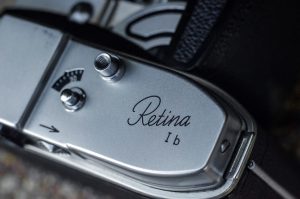 Regarding the Retina Ib (not to be confused with the later “Big B” Retina IB), why do I declare that the Ib is my favorite Retina? Well, for starters, I am not foolish to suggest that any one model is universally “the best” because whats best for me won’t be for someone else. We all have our own priorities and preferences that for anyone to suggest one model is universally better than all others is silly. I’d also say that while I have not yet handled every single Retina model ever made, I have handled enough of them to know that there is no one perfect model. In my opinion, there are pros and cons for every model.
Regarding the Retina Ib (not to be confused with the later “Big B” Retina IB), why do I declare that the Ib is my favorite Retina? Well, for starters, I am not foolish to suggest that any one model is universally “the best” because whats best for me won’t be for someone else. We all have our own priorities and preferences that for anyone to suggest one model is universally better than all others is silly. I’d also say that while I have not yet handled every single Retina model ever made, I have handled enough of them to know that there is no one perfect model. In my opinion, there are pros and cons for every model.
If the Retina Ib is not perfect, why is it my favorite Retina? I feel that the Retina Ib most closely matches my shooting style the best and it offers the best compromise of whats good about all of the Retina models, with a minimal number of the “yeah…buts”.
Lets start with the good…
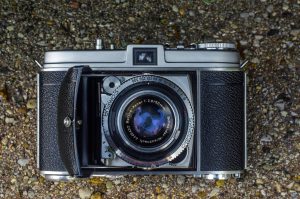
- The Design – Let’s be honest here, ALL Retinas are gorgeous. They’re well built examples of fine German craftsmanship made with an eye for looks and a dedication to quality. These were not cheap cameras. The Retina Ib likely sold somewhere in the neighborhood of $100 upon it’s release in 1954 which when adjusted for inflation is like $917 today. Beyond the beauty, in 1954 all Retina models were redesigned with a curved film door that was easier to open and close than earlier models. The bellows were completely hidden behind a metal ‘box’ which all but guaranteed that nothing could poke the delicate bellows and damage them. These models also switched to a bottom wind system (which I’ll get to later) which I’ll at least say was neat. Like the Retina IIc, the Ib is my favorite looking model in my collection.
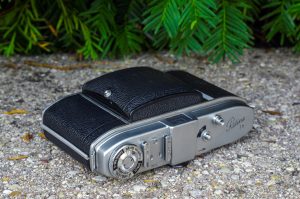
-
- The Size – Although the entire Retina line generally got larger and heavier throughout it’s life span, the Ib is a nice ‘in-between’ model that when folded, is still very compact and portable, but hasn’t quite grown to the bulbous size of the later models with selenium exposure meters and huge rangefinders.
- The Photos – This one is kind of a given as all Retinas are capable of amazing photos, so this ones basically going to be a tie across the entire product range. The Schneider-Kreuznach Xenar on this camera is a 4-element design, as opposed the 6-element Xenons on higher spec Retinas. On paper, the Xenar vs Xenon discussion might suggest this camera has inferior optics, but in reality I don’t see it in the images it makes.

- Viewfinder Brightness – Compared to all previous Retinas, the Retina Ib has a really nice compromise between size and brightness, plus it has projected frame lines to indicate the 50mm frame. The Ib’s viewfinder is larger than all scale focus Retinas that came before it, and because it doesn’t have a rangefinder, there is no beamsplitter, making the image brighter than rangefinder Retinas of the era. The image to the right was taken with my cell phone through the viewfinder. The projected frame lines were very difficult to capture, but I assure you they are there.
- Zone Focus – This feature in my mind, is the best thing about the Ib and why I like it better than the rangefinder models I’ve used. Both the IIa and IIc are great cameras, but compared to other rangefinders from the 50s and 60s, their rangefinders are still quite small. In the years I’ve owned both the IIa and IIc, I rarely come back to them when I want to shoot with a classic mid-century rangefinder. They’re just not that easy to use for someone like me with prescription glasses.
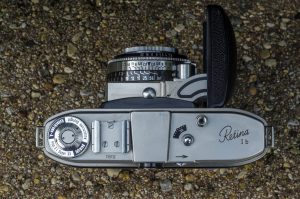
The top plate of the Retina has a film reminder dial, accessory shoe, exposure counter, shutter release, and that beautiful Retina logo. Another advantage that applies to all scale focus cameras is that when used correctly, zone focusing is very fast. I’ll spare the technical explanation, but in a nutshell, if you shoot a scale focus camera in a well lit outdoor area, and set your aperture to somewhere around f/8 and the focus to around 10 or 15 feet, you maximize the distance between you and objects far away that will be in focus.
The Retina Ib has two little circles on the focus scale at 10 feet and 25 feet as reference points for these distances. According to the manual, with the lens set to f/8 and the focus set to the first circle at 10 feet, everything from 7 feet all the way to 20 feet away will be in focus. This distance is the range in which most people shoot group photos or images of a single person in which you can see their entire body in frame. With the camera still at f/8 and the focus set to the second circle near 25 feet, everything from 11 feet to infinity will be in focus. An easy way to estimate how far away 11 feet is, is that using a 50mm lens (like on the Retina Ib), 11 feet is the correct distance you’d need to stand away from a 6 foot tall person to get both their head and their feet comfortably in frame. If you are not taking a photograph of a person, think of being at a zoo watching wild animals. Most zoos have barriers keeping you at least 10 feet from the barrier so you don’t fall in. I love zone focus and find it much faster to move myself into a range where I know my subject will fall into the correct depth of field, rather than analyzing a rangefinder looking for a vertical line, and slowly turning the focus to make sure everything lines up correctly. I can shoot 3 pictures using zone focus in the time it takes me to shoot an image while using a rangefinder. And don’t even get me started on the Retina Reflex…
Now for the not so good…
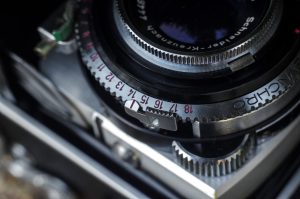
- Light Value System – The Ib still has the dreaded Light Value System that Kodak graced all Retina models with starting in 1954. I don’t fundamentally hate all LVS systems as some manufacturers designed them well. Yashica, Ricoh, and Minolta all made cameras where the LVS system can easily be overridden, but Kodak, like Meopta and Aires, has a system in which the shutter speed and aperture selector are physically linked together and you must override them by moving a pin or a lever. This is just ludicrous as I am going to want to change my shutter or aperture settings based on available light much more than I’m going to want to change settings while staying at the same light value. I get the idea of the system, but Kodak’s implementation if it is quite poor and one reason I can’t proclaim either the Ib or the IIc to be “the perfect Retina”.
- Difficulty with Close-Ups – This is a weakness of almost every scale focus camera. The very nature of zone focus requires a wide depth of field, and in order to get that you need to shoot things that are somewhat far away. If you are interested in close-ups, or highly out of focus backgrounds, a scale focus camera is not your friend. Anything closer than 7 feet requires precise focus, and the closer you get the more true this becomes. Sure, there are things you can do to help with close focus, but it’s generally not a pleasant experience. I find that it’s just better to use a different camera if I want to shoot closeups.
- Viewfinder Size – I am including the viewfinder in both the good and bad because although it is much larger than the ones in earlier Retinas, it’s still a far cry from the gloriously large ones in cameras like the Voigtlander Vitomatic or the AGFA Optima. I found that I didn’t struggle shooting with the Ib while wearing prescription glasses, but only barely.
And the stuff that’s neither good nor bad, but still worth mentioning…
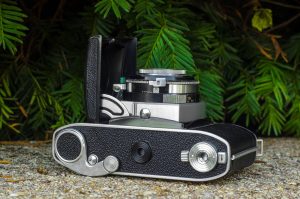
- All Retina cameras sold in 1954 and after switched to a bottom wind system. I’ve read a variety of explanations online as why this was done. Some say that the bottom wind was done because it was thought to be faster than a top wind as it could be operated with the camera to your eye without having the wind lever smack you in the forehead. I’ve also read that this was done more as a necessity of the design in that Kodak was able to simplify the internal mechanics of the camera by moving the wind lever to the bottom. Regardless of the reason, in the time I’ve shot this, and a myriad of other similar cameras with bottom wind levers, I find it neither to be better or worse, just different.
- Another quirk that all Retinas have is that the frame counter counts down instead of up. This means that when loading in a fresh roll of film, you have to manually set it to the total number of exposures left in the roll. So in a 36 exposure roll, set the counter to 36 and as you take each photo, it counts down to 0 letting you know how many exposures are left. While this actually makes a bit of sense to show the number remaining as opposed to how you’ve already shot, all Retinas have a shutter lock that will engage when the frame counter hits 0. If you are like me and like getting an extra exposure on the film leader, you need to reset the counter in order to get that last shot or two out of your roll. I also believe that this shutter lock is the cause of many Retinas sold as having a broken shutter, because the camera is at 0, and the lock is preventing the shutter from firing.
I have had the pleasure of handling almost every Retina (folding, non folding, and SLR), and while there are still a couple that I would like to one day experience, I can say with absolute certainty that there has never been a “perfect” Retina. A few have come close, and there’s some things that some models have that I love, but there’s always a “con”.

There are many fans of Retinas in particular, and I would be willing to bet that most of them would scratch their heads at someone like me declaring the Ib as being his favorite. I went into good detail above about the things I like and don’t like about the camera, but I’ll summarize by saying this camera most closely matches my shooting style. I’ll still never understand why Kodak went with the LVS in the way they did, but it’s hardly a deal breaker. I do appreciate the more compact size of the earlier models, but I think that with what you get in this slightly larger model, the increase in size is worth it.
I think the thing that is so impressive is that on paper, this is an entry level camera. It lacks almost all modern conveniences, there is no focus aide, no exposure aide, and everything is completely manual, yet the Retina Ib was built to the same high level of precision and quality as every other Retina. This is not a cheap camera aimed at the beginning photographer. This is a fine precision instrument that strips away almost everything (except that damned LVS system) and offers a pure and uninterrupted shooting experience that you don’t often get in entry level cameras.
Perhaps the greatest thing about the Retina Ib is that they are quite common on the used market but rarely are the first, second, or even third Retinas recommended by collectors, so their price remains low. A search of recently sold eBay listings shows 14 Retina Ib’s sold with a price of $30 or less. According to this archived page, over 160,000 Retina Ibs were made between 1954 and 1957 making them one of the more common Retina types out there, so finding one cheaply shouldn’t be difficult.
My Results
My first roll of film shot through the Retina was a roll of fresh Fuji 200 in the summer of 2017 at my uncle’s 50th birthday party. I figured that the Retina was a family snapshot camera for the photographer that might have wanted something that was quick and easy to use without skimping on quality. In an attempt to stay true to the Retina Ib’s strengths, I maximized the bright sunlit scenes and kept the aperture in the f/5.6 to f/11 range and kept all my subjects in a comfortable zone focus distance of 10 to 20 feet away.
Although I am only showing 8 of the 24 images from my first roll of Fuji 200, I will tell you that all but 2 of the images were correctly in focus. I either misjudged my distance or accidentally changed something on the camera in the 2 that I missed. I think that a greater than 90% yield of in-focus shots from a scale focus camera that I had never used before was quite impressive and it reinforces my love for the simplicity of this camera.
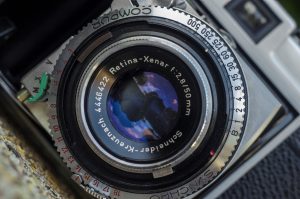
If there was ever a camera that I could recommend to a beginning photographer who wanted to experience scale focus, the Retina Ib is it. The build quality is outstanding, when folded it is extremely portable, and compared to many other scale focus cameras of the early to mid 20th century, the viewfinder isn’t cripplingly small.
At the risk of repeating myself too often in this review, I’ll declare the Retina Ib to be my favorite Retina because it has the best combination of build quality, size, optics, and a feature set that doesn’t get in the way. I am strongly considering seeing if there is a way for me to completely defeat the LVS scale in a way that is not permanent and see if that one single change elevates my declaration to saying that the Retina isn’t just my favorite, but the best Retina ever.
If you have an opportunity to pick one of these up, but are apprehensive about it’s feature set, don’t hesitate. Pick it up, load in some film and shoot it. I challenge you to not like it!
My Final WordHow these ratings work |
The Kodak Retina Ib, like every Retina ever made, is a fine example of German precision and workmanship. The overall design of the camera and the lens make for a very capable camera. Although an entry level model in the Retina range, this camera is a considerable improvement from other entry level cameras made by other companies. I won’t declare that the Retina Ib is perfect as it has a few annoyances, but when taken as a whole, I found it to be the most effective Retina in my collection and one that most closely matches my shooting style. I thoroughly enjoyed shooting with the camera, and when used to it’s strengths, makes for a very fast and capable camera. Don’t let the lack of modern conveniences like a rangefinder or exposure meter deter you from picking one up, this is a great camera! | ||||||
| Images | Handling | Features | Viewfinder | Feel & Beauty | History | Age | |
| 2 | 2 | 1 | 1 | 2 | 1 | 30% | |
| Bonus | +1 for the complete package, a well designed camera that’s easy to use and doesn’t get in the way | ||||||
| Final Score | 12.7 | ||||||
Additional Resources
http://camerapedia.wikia.com/wiki/Kodak_Retina_Ib
http://retinarescue.com/retina1btype018.html
http://elekm.net/pages/cameras/retinaib.htm
http://www.eyescoffee.com/collectcamera/kodakretina1b/index.php

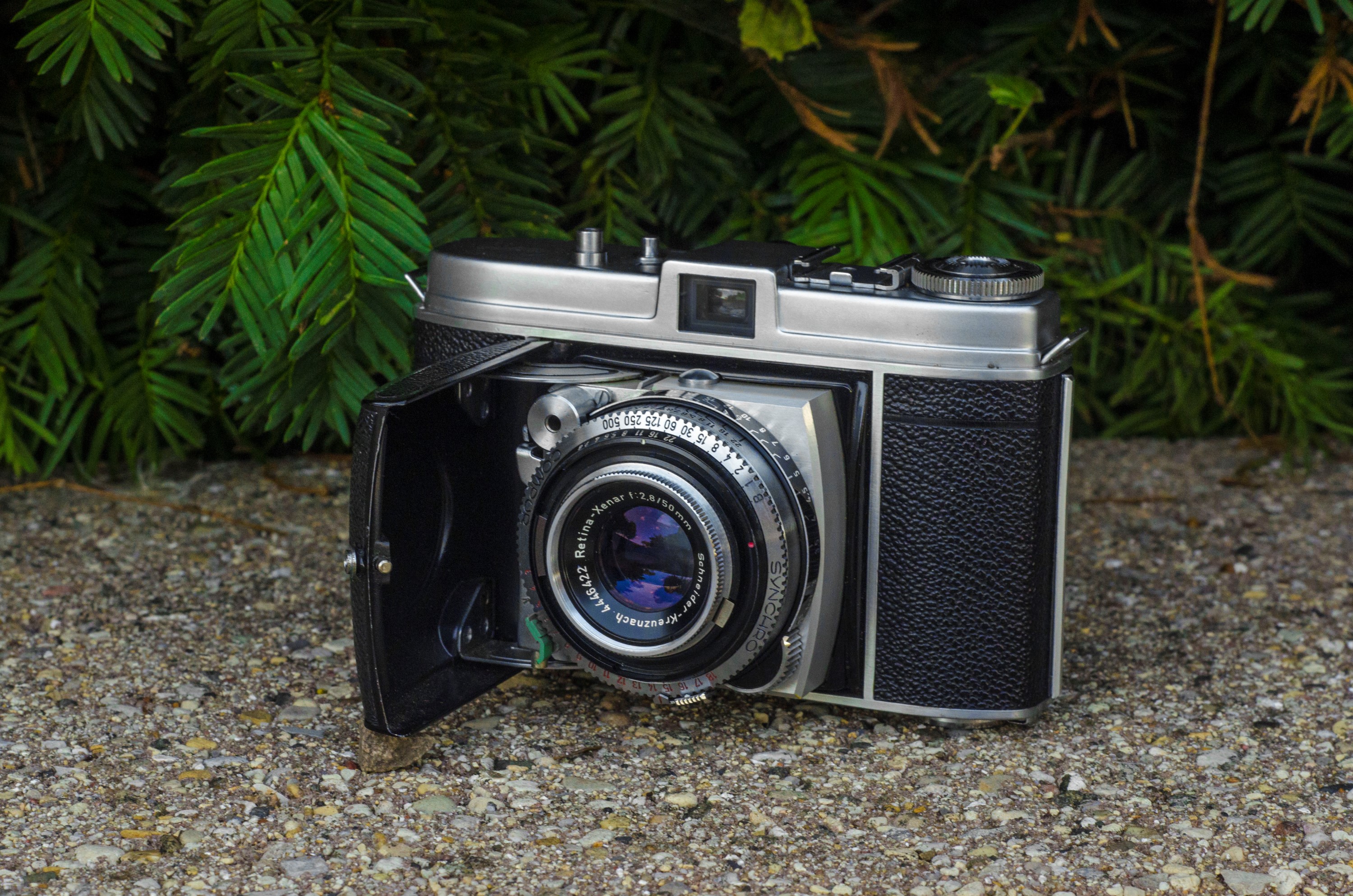
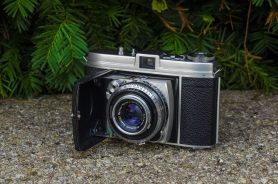
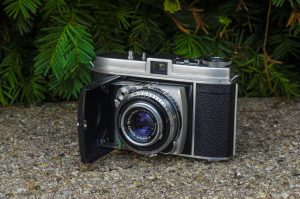








If you shoot meterless cameras using a light meter app on your iPhone, as I do, the EV system suddenly isn’t so bad — because most meter apps will read in EVs. Dial in your EV and then adjust the shutter/aperture pair to get the DOF you want. Easy.
I don’t mind using an external light meter, and I understand how EV and LV systems work (although it’s worth mentioning that a LVS like the one on the Retina does not take into account film speed, so if you had an EV number from a meter, you’d have to convert it to match whatever speed film you are using), I just hate how Kodak designed it here.
Lets say you’re walking around at the zoo and you are regularly shooting scenes that are in and out of shade. Your shutter speed and f/stops are physically coupled together. If you want to only change the shutter speed or aperture size to account for a change in light, you have to pull down on the little pin at the bottom of the camera to “de-couple” the system, and then point it to a different LV number to get a corresponding change to the f/stop. If you wanted to keep the f/stop the same and change shutter speed to account for a change in light, you still need to de-couple the system, then while holding the f/stop dial still, with your other hand change the shutter speed dial. It’s a poorly designed system.
Ah yes, having to adjust aperture or shutter speed independently is a total pain on these. Good point.
Oh, I kept HOPING as I read through the good points that the LACK of the Kodak LVS system would be among those points. I love a scale focus camera and pushing it to the limits where I can, and I enjoy the experience of manual exposure as well, but the implementation of the LVS scale as a “feature,” in the same kludgy manner as one of my Retinettes, would relegate this as one to skip. Otherwise, it does have so much going for it!
Hallo Mike,
kind regards from Germany and many thanks for your interesting review of the Retina Ib.
I own a few of the postwar folding models Ia, IIa, Ib and IIc, both with Schneider and Heligon lenses.
My favorite Retina is the Ib, as well, for the same reasons you mentioned in your report.
Take much pleasure in your Retinas.
Kind regards,
Dieter
Hello Dieter, I just purchaced a Retina 1 – 13 but can not find a manual . Can you help me?
Greetings, Han.
Hello,
I just picked up a Kodak Retina Ib on ebay. I am an avid film shooter and I would like to protect the Schneider lens. Schneider Retina – Xenar f2.8 50mm. Do you know what size filter it would take?
Paul, the Retina Ib uses a 29.5mm screw on filter, or a 32mm slip on filter. Many Retina filters were sold in kits, simply as Kodak Retina filters, so if you search eBay, you can usually find a whole kit of them. If they say they fit the Retina, they’ll fit your camera.
I am a major Retina fan, the 1b my favorite Retina. The LVS system is a bit annoying, but I don’t mind, I am used to this classic’s few quirks. The Schneider Xenar 50mm/f2.8 is a super sharp lens. And I also like German build quality, and elegant 35 mm folders. And especially when there’s a Compur shutter involved. Taken many nice photos with a Retina 1b.